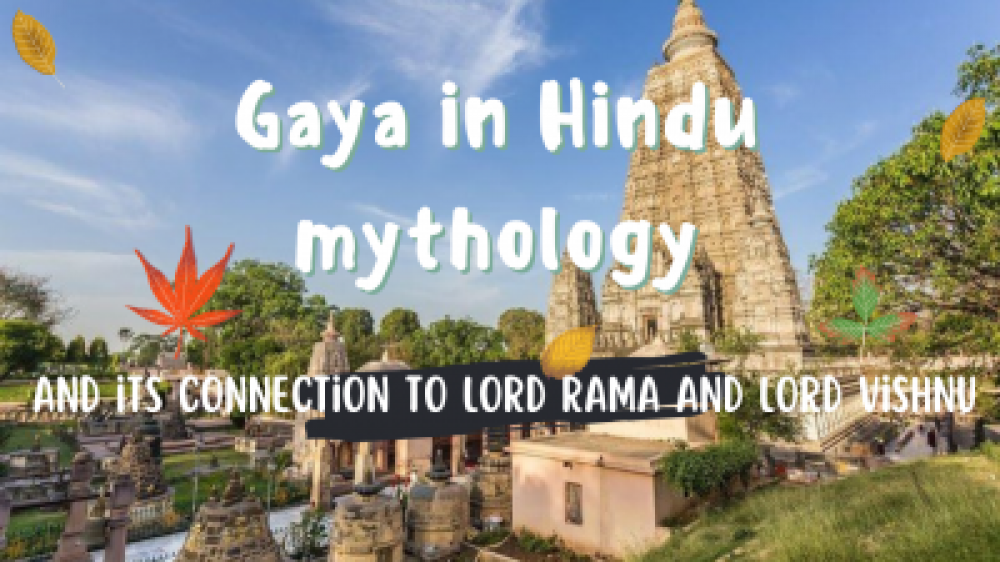The significance of Gaya in Hindu mythology and its connection to Lord Rama and Lord Vishnu


The city of Gaya, situated in the eastern Indian state of Bihar, holds profound significance in Hindu mythology and spirituality. It is revered as a sacred pilgrimage site, attracting devotees from far and wide. In this comprehensive exploration, we delve into the rich tapestry of legends, rituals, and the spiritual aura that envelops Gaya. Moreover, we will unravel the compelling connections that Gaya shares with two prominent deities of Hinduism - Lord Rama and Lord Vishnu.
1: Gaya in Hindu Mythology
1.1 The Origins of Gaya
The historical and mythological roots of Gaya trace back to ancient times. According to Hindu mythology, Lord Brahma, the creator of the universe, chose Gaya as the site to perform yagnas (sacrificial rituals). The city's name is believed to be derived from the demon Gayasura, who was defeated and subdued by Lord Vishnu.
1.2 The Legend of Gayasura
The legend of Gayasura forms a captivating narrative in Hindu mythology. Gayasura, an ardent devotee of Lord Vishnu, sought a boon of immortality. However, he wished for a unique form of immortality - that anyone who saw him should attain salvation. Pleased with his devotion, Lord Vishnu granted his wish, but with a caveat. Lord Vishnu granted Gayasura's request, but with the understanding that he would have to remain stationary and never move. To this day, the temple dedicated to Gayasura stands in Gaya, serving as a testament to this myth.
2: Gaya as an Abode of Lord Vishnu
2.1 Lord Vishnu's Footprints
One of the most revered sites in Gaya is the Vishnupada Temple, where it is believed that Lord Vishnu left his footprint. According to Hindu mythology, Lord Vishnu descended to Gaya to offer salvation to Gayasura. It is said that Lord Vishnu's footprint can still be seen on a large rock within the temple, symbolizing his divine presence in the city.
2.2 Pindaan Rituals for Ancestors
The practice of Pindaan, or offering oblations to one's ancestors, holds immense significance in Hinduism. Gaya is considered one of the holiest places for performing these rituals. It is believed that by offering Pindaan in Gaya, one can help their ancestors attain salvation. This ritual is performed at various sacred sites across the city, including the renowned Akshaya Vat, a sacred banyan tree.
3: Gaya's Connection to Lord Rama
3.1 Ramayana and Gaya
The epic Ramayana, which narrates the life and adventures of Lord Rama, has strong ties to Gaya. It is believed that Lord Rama and his wife Sita visited Gaya during their exile in the forest. Gaya's significance in the Ramayana is marked by the presence of several temples and sites associated with Lord Rama's visit.
3.2 Phalgu River and Lord Rama's Offerings
Phalgu River, which flows through Gaya, holds a unique connection to Lord Rama. According to legend, Lord Rama offered pindas (rice balls) to honor his father, King Dasharatha, in the sacred waters of the Phalgu River. This tradition is carried forward today through the Pindaan rituals performed by devotees in Gaya.
4: Gaya as a Pilgrimage Destination
4.1 Mahabodhi Temple - A UNESCO World Heritage Site
While Gaya's connection to Lord Vishnu and Lord Rama is profound, it is also known as the place where Lord Buddha attained enlightenment. The Mahabodhi Temple, a UNESCO World Heritage Site, stands as a testament to this pivotal event in Buddhism. Pilgrims from across the world visit this temple to pay their respects and meditate under the Bodhi Tree.
4.2 Multifaceted Pilgrimage Destination
Gaya is not only a destination for Hindu pilgrims but also attracts followers of Jainism and Buddhism. The city is home to several Jain temples and is closely associated with Lord Mahavira, the 24th Tirthankara of Jainism. This multi-religious and spiritual diversity adds to the unique character of Gaya.
5: Rituals and Traditions in Gaya
5.1 Pindaan Rituals
The Pindaan rituals in Gaya are meticulously performed by devotees seeking to pay homage to their ancestors. These rituals involve offering pindas (rice balls) in the sacred waters of the Phalgu River or at other designated sites. It is believed that by doing so, the souls of the departed find liberation and move towards moksha (salvation).
5.2 Tarpan Rituals
Tarpan is another important ritual conducted in Gaya, where offerings of water are made to the ancestors. Devotees believe that this act helps the souls of their ancestors find peace and attain spiritual liberation.